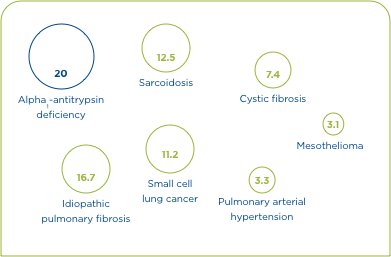Alpha1-antitrypsin (AAT) deficiency is underdiagnosed
Based on a survey of 58 countries, it is estimated that worldwide there are:
- 3.4 million individuals with severe deficiency (PiS and PiZ allele combinations)1
In the United States:
- Over 90% of people with AAT deficiency are believed to be undiagnosed2,3
- Up to 3% of all chronic obstructive pulmonary disease (COPD) cases may be due to an underlying AAT deficiency2
Alpha1-antitrypsin (AAT) deficiency in comparison to other rare pulmonary diseases3

AAT deficiency may be underdiagnosed because respiratory symptoms of AAT deficiency are indistinguishable from smoking-induced COPD or asthma, chronic bronchitis and emphysema (usually in combination)4,5, including:
- Wheezing4,5
- Cough4,5
- Excess sputum production4,5
- Severe dyspnoea on exertion4,5
A history of smoking confound the proper diagnosis of AAT deficiency: many AAT deficiency patients are either current or ex-smokers.6,7
Because no clinical characteristics rule out the diagnosis of AAT deficiency, and no demographic or age-related characteristics can predict AAT deficiency, it is underdiagnosed and should be confirmed with laboratory testing.2,8-11
Once diagnosed, patients can be counselled to adopt healthier lifestyles, particularly with regards to smoking and other preventative measures.2
Since AAT deficiency is a genetic disease, early detection may also help a patient’s relatives regardless of whether or not they are symptomatic.2
References
- de Serres FJ. Worldwide racial and ethnic distribution of alpha1-antitrypsin deficiency: summary of an analysis of published genetic epidemiologic surveys. Chest. 2002;122(5):1818-29.
- Campos MA, Wanner A, Zhang G, et al. Trends in the diagnosis of symptomatic patients with alpha1-antitrypsin deficiency between 1968 and 2003. Chest. 2005;128(3):1179-86.
- Orphanet Report Series. Prevalence and incidence of rare diseases: January 2019 - Number 1. 2019 [Updated]. Available at: http://www.orpha.net/orphacom/cahiers/docs/GB/Prevalence_of_rare_diseases_by_alphabetical_list.pdf
- Rachelefsky G, Hogarth DK. Issues in the diagnosis of alpha 1-antitrypsin deficiency. J Allergy Clin Immunol. 2008;121(4):833-8.
- Strange C, Stoller JK, Sandhaus RA, et al. Results of a survey of patients with alpha-1 antitrypsin deficiency. Respiration. 2006;73(2):185-90.
- DeMeo DL, Sandhaus RA, Barker AF, et al. Determinants of airflow obstruction in severe alpha-1-antitrypsin deficiency. Thorax. 2007;62(9):806-13.
- The Alpha-1-Antitrypsin Deficiency Registry Study Group. Survival and FEV1 decline in individuals with severe deficiency of alpha1-antitrypsin. Am J Respir Crit Care Med. 1998;158(1):49-59.



think what AAT
AAT: alfa1 antitripsina; COPD: chronic obstructive pulmary disease.